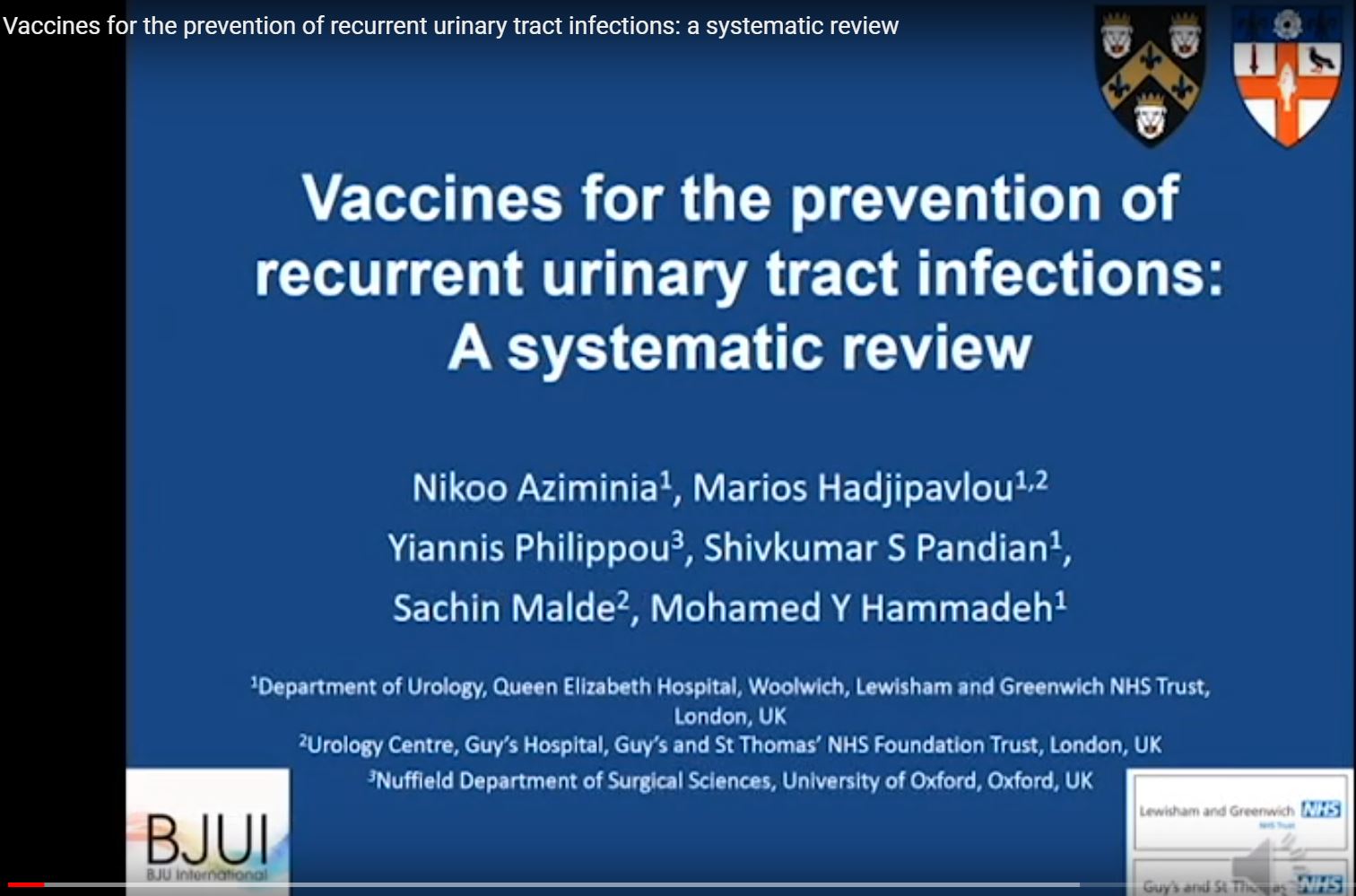The current ‘hot topic’ in UTI is antibiotic‐free prevention. At the forefront of this is the development of new immunomodulating vaccines, which utilise the most common strains of uropathogens, both surface antigen or inactivated whole bacterium, to induce a host immune response to prevent recurrent infections. Vaccines currently with established randomised control trials (RCTs) are Uro‐Vaxom® (OM Pharma, Myerlin, Switzerland), Urovac® (Solco Basel Ltd, Basel, Switzerland) and ExPEC4V (GlycoVaxyn AG, Schlieren, Switzerland), which have recently been reviewed by Aziminia et al. [1].
Vaccines classically work by inducing a systemic adaptive host immune response by pre‐sensitisation to the bacterial surface antigen. As most uropathogens share similar antigenic structures, a broad spectrum response is possible against other pathogens and not limited solely to the bacteria within the vaccine itself.
UroVaxom® is an oral tablet composed of bacterial extracts from 18 strains of Escherichia coli given daily for 90 days. Its use has been reported in the literature since 1990 and was found in the systematic review to reduce UTI recurrence rates the most (risk ratio [RR] 0.67, 95% CI 0.57–0.78).
Urovac® is composed of 10 inactivated uropathogen strains including six E. coli strains and one Proteus mirabilis, Morganella morganii, Enterococcus faecalis and Klebsiella pneumoniae. It is delivered as a weekly vaginal suppository for three doses, followed by three booster doses at 6, 10 and 14 weeks. Urovac® has also been shown to effectively reduce UTI recurrence rates (RR 0.75, 95% CI 0.63–0.89).
ExPEC4V is composed of O‐antigens of four E. coli serotypes delivered as a single i.m. injection. Whilst effective in initial trials, to date there is only one RCT, which reported no reduction in UTI recurrence rates (RR 0.82, 95% CI 0.62–1.10).
Overall, Aziminia et al. [1] concluded that a firm conclusion about the efficacy of UTI vaccines could not be reached. The studies thus have in general been limited by many factors, including the definition of what constitutes a UTI, the heterogeneity of participants, and variable definitions of trial endpoints, making comparisons difficult [1]. More targeted research is therefore needed.
UTI is a major problem and is one of the most common infections worldwide, affecting disproportionately more women than men. In the UK, 40–50% of women experience at least one episode of UTI in their lifetime, of which 20–30% proceed to develop recurrent UTIs (as defined by three or more episodes of UTI within a 12‐month period) [2,3]. Yet despite its prevalence, mainstream preventative options rely heavily upon long‐term antibiotic usage, either as low‐dose prophylaxis or recurrent rescue courses.
However, the problem is the concurrent and rapid rise in global bacterial multidrug resistance, such that the WHO has declared antibiotic resistance as one of the biggest risks to public health in our lifetimes and created a Global Action Plan to combat this issue. There is, therefore, an urgent need to find antibiotic‐free alternatives.
More recently, site‐targeted immune response has been shown to be effective in delivering a UTI vaccine. In particular, the genitourinary tract harbours both an innate and adaptive mucosal immune system. Within this there is mucosa‐associated lymphoid tissue (MALT) through which immunocytes transit. This is part of a larger mammalian lymphoid organ system. Stimulation at one MALT site induces an activation and dissemination of immunity to other MALT sites. In particular the activation of the sublingual mucosa has been linked with a broad spectrum immune response in the genitourinary tract [4].
Uromune® (Q‐Pharma, Alicante, Spain) is a new sublingual vaccine targeting this pathway. Composed of inactivated E. coli, Klebsiella pneumoniae, Proteus vulgaris and Enterococcus faecalis, it has been shown in two large retrospective Spanish studies to decrease UTI recurrence by up to 90% when compared to antibiotic prophylaxis [5]. A prospective UK observational study found after 3 months of daily administration, 78% of women developed no further UTIs in the 12‐month follow‐up period [6]. To date, there is no RCT available on the efficacy of Uromune®, although one international multicentre phase III RCT is currently underway, due to report in 2019/2020.
In general, whilst initial trials on UTI vaccines show potential, further research is needed to bring UTI vaccinations into mainstream treatment. In particular, future trials need to have robust definitions of the following (which previous studies have often lacked):
- Definition of UTI – presence of symptoms and bacteriuria, as opposed to asymptomatic bacteriuria, which is often self‐limiting; and
- Defined eligibility criteria – previous studies included hugely variable populations that included patients with neurogenic bladders, males and females, patients with indwelling catheters, and even immunosuppressed patients.
Furthermore, whilst comparison against placebo is important, comparison against antibiotic prophylaxis, the current ‘gold standard’, is also vital in providing evidence of efficacy.
Finally, the longevity of the vaccines’s effects also needs to be determined, in particular whether and when a booster dose is required in order to maintain the immune memory.
Overall though the future is exciting on tackling this ‘burning issue’ of UTI prevention.
References
- Aziminia, N, Hadjipavlou, M, Philippou, Y, Pandian, SS, Malde, S, Hammadeh, MY. Vaccines for the prevention of recurrent urinary tract infections: a systematic review. BJU Int 2019; 123: 753– 68
- Foxman, B. Urinary tract infection syndromes: occurrence, recurrence, bacteriology, risk factors, and disease burden. Infect Dis Clin North Am 2014; 28: 1– 13
- Albert, X, Huertas, I, Pereiró, II, Sanfélix J, Gosalbes V, Perrota C. Antibiotics for preventing recurrent urinary tract infection in non‐pregnant women. Cochrane Database Syst Rev 2004; 3:CD001209
- Holmgren, J, Czerkinsky, C. Mucosal immunity and vaccines. Nat Med 2005; 11 ( Suppl.): S45– 53
- Yang, B, Foley, S, Toozs‐Hobson, P. Urinary tract infections: current and new preventative options. SM J Clin Med 2016; 2: 1018
- Yang, B, Foley, S. First experience in the UK of treating women with recurrent urinary tract infections with the bacterial vaccine Uromune®. BJU Int 2018; 121: 289– 92















